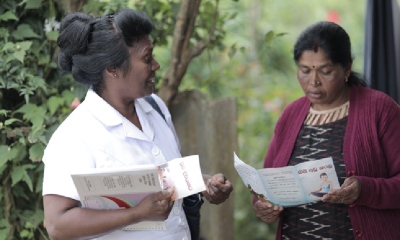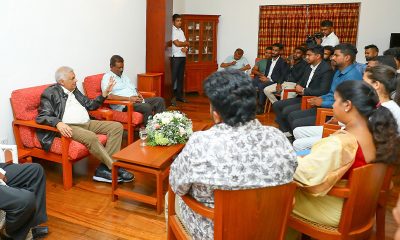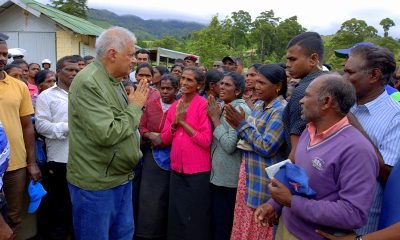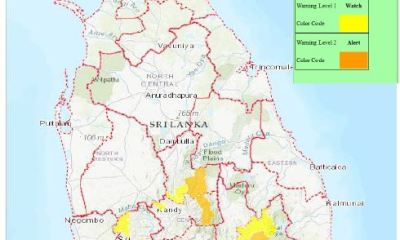Features
The Thucydides Trap and Bilateral Relations
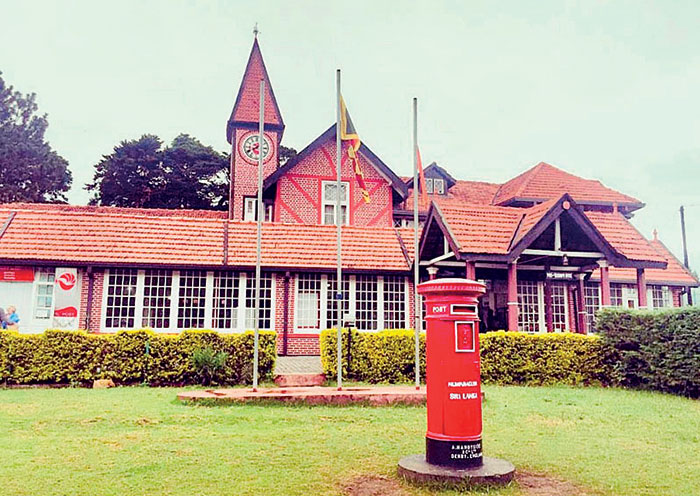
by Dr Sarala Fernando
In an earlier article I had written about the return of “might is right” to international geopolitics affecting for example Ukraine and Palestine. In both cases ambitions of ” imperial expansion” by powerful nations is being met with resistance from the weaker neighbour in favour of “values of freedom and territorial integrity”. Political science students and military strategists are much influenced today by the notion of the “Thucydides Trap” coined by Graham Allison in his book “Destined for War” referring to Thucydides, an Athenian historian of the 5th century B.C.E who ascribed the great wars of the period to “the rise of Athens and the fear that instilled in Sparta that made war inevitable”. Allison reminds that history has provided several examples both where the clash of powerful nations ended in war and where war was avoided by effective diplomacy and wisdom depending on the character of the nations concerned and the values of their rulers.
Can this notion be a useful basis for the examination of bilateral relations between nations of unequal size and power? Can it explain why has there has been continuous fall-out from the President’s official visit to India in July especially as details become clear of the thrust of the India Sri Lanka Economic Partnership Vision dated July 21, 2023? The emphasis on “connectivity in all its dimensions as the key enabler” has been contested in the island to such an extent that it now seems to cast a shadow over Indian investment proposals however benign.
To take a recent example, the President was seen on live tv demanding that the historic Nuwara Eliya post office be given to India’s Taj group for redevelopment over the objections of the postal workers. What is interesting is that the storm of protest from the postal workers has been joined by other unions, including academics, leading hoteliers and some caution voiced even by the Mahanayakes. In the current thoughtless rush for foreign investment, questions are raised as to whether Nuwara Eliya needs another large hotel? It is after all a place of seasonal demand and any new luxury hotel which will capture the Indian tourist market will affect the local hotels there negatively.
In this time of crisis, should not government action be in support the local hoteliers instead of taking away their business across the Palk Straits? It is just another example of poor public diplomacy from the top given that its hardly likely that the Indian owners of Taj would want to get embroiled in such a public confrontation and would find it more embarrassing than helpful to their cause.
However, what is even more interesting is that the protests have stimulated a suggestion that the President’s House in Nuwara Eliya be given instead of the historic post office for redevelopment by the Taj group. It seems “the worm has turned” and the public is no longer willing to be at the end of this process of “selling the family silver”.
Indeed why should the rulers also not share the pain? Offering the Presidential House to the Indian investors would be a good political gesture and an excellent business proposition, enabling considerable savings from the President’s budget. The commercial development, with only a Presidential suite reserved for official use, will open up this building for better public viewing and use.
Many see the public berating of public service officials as an unhealthy precedent especially at a time when the cost of living is sky rocketing with the imposition of new taxes. It can only lead to widening of the gap between the rulers and the ruled and grow public skepticism about the direction of government strategy and thinking.
The postal service is a good example of this increasing divide, where the government only sees it as “loss making” in opposition to the general public who see the value of the Sri Lanka postal service which has maintained an excellent service even in times of crisis, able to deliver registered letter to the remotest corner of the island in a few days.
Recently, I visited the CTO to collect an undelivered registered letter and was amazed at the hive of activity in this old building with dust everywhere, bags of mail flying up and down despite the poor working conditions without proper lighting or ventilation. Since the ancient public lift was not working, kind courteous staff took me to the section concerned where my letter was found in a matter of minutes because of the systems in place.
Should not our rulers encourage and support local public services which are working well instead of trying to disrupt and destroy the morale of the workers? Should they not be turning to local entrepreneurs to stimulate business activities in these historic buildings and aiding their conservation instead of selling them off to foreign parties?
The confusion over basic economics is everywhere. Thus, even within the Cabinet, one Minister champions importing eggs from India over the objections of local producers and disrupting market prices. Has there been an accounting of the precious foreign exchange used for these purchases and whether the government cooperative Sathosa ran a profit from the lowering of egg prices?
Shouldn’t we be encouraging and finding ways to support local producers affected by the economic crisis? Posted to Switzerland some years ago I could not but notice how the Swiss brand is encouraged and local producers supported such that their consumers were willing to pay a higher price for their own products even though, across the open border, French stores sold everything from wine to cheese of similar or better quality much cheaper. The Swiss example shows the importance of building pride in the country and encouraging high standards of local manufacture. In my mind, import substitution, which is scorned by economists, is not a bad thing in practice especially at a time of crisis. National campaigns like “Make in India” are a good example of how to boost local production and stimulate national pride, even while the emphasis is on exports.
All these recent developments are raising questions on the present government strategy to “let the robber barons come”. Is any footloose foreign investment acceptable or should we be cautious about what is of real value to this country? Should we encourage for example the building of Asia’s tallest Buddha statute even as a state gift which will require mountains to be flattened for stones and digging more rivers for sand, causing more environmental damage at a time of climate crisis? Will this new monument cast into shadow the beauty of our ancient cultural assets and revive the conflict between Mahayana and Theravada streams?
Fortunately for India-Sri Lanka relations, the visit of the Indian Minister of Finance, that brilliant woman, economist and politician, Nirmala Sittaraman took place recently and the sincerity of her approach would have strengthened India’s public diplomacy. The political element, a huge gathering of Indian Tamil plantation community in Colombo, was balanced by the Indian Minister’s association with down to earth projects such as providing solar power assistance to places of religious worship hard hit by escalating electricity bills, interest in supporting educational projects and digitalization, walk about meeting young students at a tech fair in Jaffna etc.
As for the political elements, I wonder if anyone showed the Indian Minister the recent press release issued by the Planters Association noting all the progress made in the status of the Indian plantation labour community over the years, including health education and housing benefits. It is worth noting that their workforce has reduced in the RPC’s now to approximately 100,000 from an estimated 300,000 once strong community, with labour migrating out of the plantation sector.
In this time of uncertainty, bilateral defence cooperation between India and Sri Lanka is continuing to grow with regular high level exchanges, joint drills and enhanced training opportunities extended to the tri-services. Yet many questions remain of public concern. When the Indian Air Force aerobatics team came to display their prowess in Sri Lanka at the invitation of our Air Force, the public were asking about the costs incurred in this celebration of jets screeching overhead for days when the public were queuing for petrol, diesel and cooking gas.
Environmentalists are still asking questions whether the Malabar exercises in the Indian Ocean caused a huge pod of pilot whales to beach in Sri Lanka for the first time, possibly disoriented by submarine sonars. In the US, environmentalists have gone to court and got such drills and exercises canceled in sensitive coastal areas of marine habitation.
It is therefore fair to conclude that India’s interest to strengthen its military power in the region is coming into public conflict . In Sri Lanka, a decade after the end of the armed conflict, Sri Lankans are still waiting for a peace dividend and a reduction of defence expenditure in the budget in favour of increased social spending on national health and education systems. In the Maldives, it appears that previously accepted military aircraft as gifts from India have now run into controversy when it was found that as many as 75 Indian personnel were in the country to maintain and service the equipment.
Questions are now being asked in that country whether gifts of valuable military equipment could be a “deceptive method of positioning Indian soldiers within Maldivian borders”. It is only a matter of time before similar questions will be raised on the terms and conditions of the gift of a Dornier aircraft to Sri Lanka especially on the provision for our cash- strapped island to purchase another? How many Indian airmen are here to ostensibly train and service the Indian made aircraft and will this become a permanent stationing in Sri Lanka?
(Sarala Fernando, retired from the Foreign Ministry as Additional Secretary, her last Ambassadorial appointment was as Permanent Representative to the UN and International Organizations in Geneva . Her Ph.D was on India-Sri Lanka relations and she writes now on foreign policy, public diplomacy and protection of heritage).
Features
The heart-friendly health minister

by Dr Gotabhya Ranasinghe
Senior Consultant Cardiologist
National Hospital Sri Lanka
When we sought a meeting with Hon Dr. Ramesh Pathirana, Minister of Health, he graciously cleared his busy schedule to accommodate us. Renowned for his attentive listening and deep understanding, Minister Pathirana is dedicated to advancing the health sector. His openness and transparency exemplify the qualities of an exemplary politician and minister.
Dr. Palitha Mahipala, the current Health Secretary, demonstrates both commendable enthusiasm and unwavering support. This combination of attributes makes him a highly compatible colleague for the esteemed Minister of Health.
Our discussion centered on a project that has been in the works for the past 30 years, one that no other minister had managed to advance.
Minister Pathirana, however, recognized the project’s significance and its potential to revolutionize care for heart patients.
The project involves the construction of a state-of-the-art facility at the premises of the National Hospital Colombo. The project’s location within the premises of the National Hospital underscores its importance and relevance to the healthcare infrastructure of the nation.
This facility will include a cardiology building and a tertiary care center, equipped with the latest technology to handle and treat all types of heart-related conditions and surgeries.
Securing funding was a major milestone for this initiative. Minister Pathirana successfully obtained approval for a $40 billion loan from the Asian Development Bank. With the funding in place, the foundation stone is scheduled to be laid in September this year, and construction will begin in January 2025.
This project guarantees a consistent and uninterrupted supply of stents and related medications for heart patients. As a result, patients will have timely access to essential medical supplies during their treatment and recovery. By securing these critical resources, the project aims to enhance patient outcomes, minimize treatment delays, and maintain the highest standards of cardiac care.
Upon its fruition, this monumental building will serve as a beacon of hope and healing, symbolizing the unwavering dedication to improving patient outcomes and fostering a healthier society.We anticipate a future marked by significant progress and positive outcomes in Sri Lanka’s cardiovascular treatment landscape within the foreseeable timeframe.
Features
A LOVING TRIBUTE TO JESUIT FR. ALOYSIUS PIERIS ON HIS 90th BIRTHDAY

by Fr. Emmanuel Fernando, OMI
Jesuit Fr. Aloysius Pieris (affectionately called Fr. Aloy) celebrated his 90th birthday on April 9, 2024 and I, as the editor of our Oblate Journal, THE MISSIONARY OBLATE had gone to press by that time. Immediately I decided to publish an article, appreciating the untiring selfless services he continues to offer for inter-Faith dialogue, the renewal of the Catholic Church, his concern for the poor and the suffering Sri Lankan masses and to me, the present writer.
It was in 1988, when I was appointed Director of the Oblate Scholastics at Ampitiya by the then Oblate Provincial Fr. Anselm Silva, that I came to know Fr. Aloy more closely. Knowing well his expertise in matters spiritual, theological, Indological and pastoral, and with the collaborative spirit of my companion-formators, our Oblate Scholastics were sent to Tulana, the Research and Encounter Centre, Kelaniya, of which he is the Founder-Director, for ‘exposure-programmes’ on matters spiritual, biblical, theological and pastoral. Some of these dimensions according to my view and that of my companion-formators, were not available at the National Seminary, Ampitiya.
Ever since that time, our Oblate formators/ accompaniers at the Oblate Scholasticate, Ampitiya , have continued to send our Oblate Scholastics to Tulana Centre for deepening their insights and convictions regarding matters needed to serve the people in today’s context. Fr. Aloy also had tried very enthusiastically with the Oblate team headed by Frs. Oswald Firth and Clement Waidyasekara to begin a Theologate, directed by the Religious Congregations in Sri Lanka, for the contextual formation/ accompaniment of their members. It should very well be a desired goal of the Leaders / Provincials of the Religious Congregations.
Besides being a formator/accompanier at the Oblate Scholasticate, I was entrusted also with the task of editing and publishing our Oblate journal, ‘The Missionary Oblate’. To maintain the quality of the journal I continue to depend on Fr. Aloy for his thought-provoking and stimulating articles on Biblical Spirituality, Biblical Theology and Ecclesiology. I am very grateful to him for his generous assistance. Of late, his writings on renewal of the Church, initiated by Pope St. John XX111 and continued by Pope Francis through the Synodal path, published in our Oblate journal, enable our readers to focus their attention also on the needed renewal in the Catholic Church in Sri Lanka. Fr. Aloy appreciated very much the Synodal path adopted by the Jesuit Pope Francis for the renewal of the Church, rooted very much on prayerful discernment. In my Religious and presbyteral life, Fr.Aloy continues to be my spiritual animator / guide and ongoing formator / acccompanier.
Fr. Aloysius Pieris, BA Hons (Lond), LPh (SHC, India), STL (PFT, Naples), PhD (SLU/VC), ThD (Tilburg), D.Ltt (KU), has been one of the eminent Asian theologians well recognized internationally and one who has lectured and held visiting chairs in many universities both in the West and in the East. Many members of Religious Congregations from Asian countries have benefited from his lectures and guidance in the East Asian Pastoral Institute (EAPI) in Manila, Philippines. He had been a Theologian consulted by the Federation of Asian Bishops’ Conferences for many years. During his professorship at the Gregorian University in Rome, he was called to be a member of a special group of advisers on other religions consulted by Pope Paul VI.
Fr. Aloy is the author of more than 30 books and well over 500 Research Papers. Some of his books and articles have been translated and published in several countries. Among those books, one can find the following: 1) The Genesis of an Asian Theology of Liberation (An Autobiographical Excursus on the Art of Theologising in Asia, 2) An Asian Theology of Liberation, 3) Providential Timeliness of Vatican 11 (a long-overdue halt to a scandalous millennium, 4) Give Vatican 11 a chance, 5) Leadership in the Church, 6) Relishing our faith in working for justice (Themes for study and discussion), 7) A Message meant mainly, not exclusively for Jesuits (Background information necessary for helping Francis renew the Church), 8) Lent in Lanka (Reflections and Resolutions, 9) Love meets wisdom (A Christian Experience of Buddhism, 10) Fire and Water 11) God’s Reign for God’s poor, 12) Our Unhiddden Agenda (How we Jesuits work, pray and form our men). He is also the Editor of two journals, Vagdevi, Journal of Religious Reflection and Dialogue, New Series.
Fr. Aloy has a BA in Pali and Sanskrit from the University of London and a Ph.D in Buddhist Philosophy from the University of Sri Lankan, Vidyodaya Campus. On Nov. 23, 2019, he was awarded the prestigious honorary Doctorate of Literature (D.Litt) by the Chancellor of the University of Kelaniya, the Most Venerable Welamitiyawe Dharmakirthi Sri Kusala Dhamma Thera.
Fr. Aloy continues to be a promoter of Gospel values and virtues. Justice as a constitutive dimension of love and social concern for the downtrodden masses are very much noted in his life and work. He had very much appreciated the commitment of the late Fr. Joseph (Joe) Fernando, the National Director of the Social and Economic Centre (SEDEC) for the poor.
In Sri Lanka, a few religious Congregations – the Good Shepherd Sisters, the Christian Brothers, the Marist Brothers and the Oblates – have invited him to animate their members especially during their Provincial Congresses, Chapters and International Conferences. The mainline Christian Churches also have sought his advice and followed his seminars. I, for one, regret very much, that the Sri Lankan authorities of the Catholic Church –today’s Hierarchy—- have not sought Fr.
Aloy’s expertise for the renewal of the Catholic Church in Sri Lanka and thus have not benefited from the immense store of wisdom and insight that he can offer to our local Church while the Sri Lankan bishops who governed the Catholic church in the immediate aftermath of the Second Vatican Council (Edmund Fernando OMI, Anthony de Saram, Leo Nanayakkara OSB, Frank Marcus Fernando, Paul Perera,) visited him and consulted him on many matters. Among the Tamil Bishops, Bishop Rayappu Joseph was keeping close contact with him and Bishop J. Deogupillai hosted him and his team visiting him after the horrible Black July massacre of Tamils.
Features
A fairy tale, success or debacle

Sri Lanka-Singapore Free Trade Agreement
By Gomi Senadhira
senadhiragomi@gmail.com
“You might tell fairy tales, but the progress of a country cannot be achieved through such narratives. A country cannot be developed by making false promises. The country moved backward because of the electoral promises made by political parties throughout time. We have witnessed that the ultimate result of this is the country becoming bankrupt. Unfortunately, many segments of the population have not come to realize this yet.” – President Ranil Wickremesinghe, 2024 Budget speech
Any Sri Lankan would agree with the above words of President Wickremesinghe on the false promises our politicians and officials make and the fairy tales they narrate which bankrupted this country. So, to understand this, let’s look at one such fairy tale with lots of false promises; Ranil Wickremesinghe’s greatest achievement in the area of international trade and investment promotion during the Yahapalana period, Sri Lanka-Singapore Free Trade Agreement (SLSFTA).
It is appropriate and timely to do it now as Finance Minister Wickremesinghe has just presented to parliament a bill on the National Policy on Economic Transformation which includes the establishment of an Office for International Trade and the Sri Lanka Institute of Economics and International Trade.
Was SLSFTA a “Cleverly negotiated Free Trade Agreement” as stated by the (former) Minister of Development Strategies and International Trade Malik Samarawickrama during the Parliamentary Debate on the SLSFTA in July 2018, or a colossal blunder covered up with lies, false promises, and fairy tales? After SLSFTA was signed there were a number of fairy tales published on this agreement by the Ministry of Development Strategies and International, Institute of Policy Studies, and others.
However, for this article, I would like to limit my comments to the speech by Minister Samarawickrama during the Parliamentary Debate, and the two most important areas in the agreement which were covered up with lies, fairy tales, and false promises, namely: revenue loss for Sri Lanka and Investment from Singapore. On the other important area, “Waste products dumping” I do not want to comment here as I have written extensively on the issue.
1. The revenue loss
During the Parliamentary Debate in July 2018, Minister Samarawickrama stated “…. let me reiterate that this FTA with Singapore has been very cleverly negotiated by us…. The liberalisation programme under this FTA has been carefully designed to have the least impact on domestic industry and revenue collection. We have included all revenue sensitive items in the negative list of items which will not be subject to removal of tariff. Therefore, 97.8% revenue from Customs duty is protected. Our tariff liberalisation will take place over a period of 12-15 years! In fact, the revenue earned through tariffs on goods imported from Singapore last year was Rs. 35 billion.
The revenue loss for over the next 15 years due to the FTA is only Rs. 733 million– which when annualised, on average, is just Rs. 51 million. That is just 0.14% per year! So anyone who claims the Singapore FTA causes revenue loss to the Government cannot do basic arithmetic! Mr. Speaker, in conclusion, I call on my fellow members of this House – don’t mislead the public with baseless criticism that is not grounded in facts. Don’t look at petty politics and use these issues for your own political survival.”
I was surprised to read the minister’s speech because an article published in January 2018 in “The Straits Times“, based on information released by the Singaporean Negotiators stated, “…. With the FTA, tariff savings for Singapore exports are estimated to hit $10 million annually“.
As the annual tariff savings (that is the revenue loss for Sri Lanka) calculated by the Singaporean Negotiators, Singaporean $ 10 million (Sri Lankan rupees 1,200 million in 2018) was way above the rupees’ 733 million revenue loss for 15 years estimated by the Sri Lankan negotiators, it was clear to any observer that one of the parties to the agreement had not done the basic arithmetic!
Six years later, according to a report published by “The Morning” newspaper, speaking at the Committee on Public Finance (COPF) on 7th May 2024, Mr Samarawickrama’s chief trade negotiator K.J. Weerasinghehad had admitted “…. that forecasted revenue loss for the Government of Sri Lanka through the Singapore FTA is Rs. 450 million in 2023 and Rs. 1.3 billion in 2024.”
If these numbers are correct, as tariff liberalisation under the SLSFTA has just started, we will pass Rs 2 billion very soon. Then, the question is how Sri Lanka’s trade negotiators made such a colossal blunder. Didn’t they do their basic arithmetic? If they didn’t know how to do basic arithmetic they should have at least done their basic readings. For example, the headline of the article published in The Straits Times in January 2018 was “Singapore, Sri Lanka sign FTA, annual savings of $10m expected”.
Anyway, as Sri Lanka’s chief negotiator reiterated at the COPF meeting that “…. since 99% of the tariffs in Singapore have zero rates of duty, Sri Lanka has agreed on 80% tariff liberalisation over a period of 15 years while expecting Singapore investments to address the imbalance in trade,” let’s turn towards investment.
Investment from Singapore
In July 2018, speaking during the Parliamentary Debate on the FTA this is what Minister Malik Samarawickrama stated on investment from Singapore, “Already, thanks to this FTA, in just the past two-and-a-half months since the agreement came into effect we have received a proposal from Singapore for investment amounting to $ 14.8 billion in an oil refinery for export of petroleum products. In addition, we have proposals for a steel manufacturing plant for exports ($ 1 billion investment), flour milling plant ($ 50 million), sugar refinery ($ 200 million). This adds up to more than $ 16.05 billion in the pipeline on these projects alone.
And all of these projects will create thousands of more jobs for our people. In principle approval has already been granted by the BOI and the investors are awaiting the release of land the environmental approvals to commence the project.
I request the Opposition and those with vested interests to change their narrow-minded thinking and join us to develop our country. We must always look at what is best for the whole community, not just the few who may oppose. We owe it to our people to courageously take decisions that will change their lives for the better.”
According to the media report I quoted earlier, speaking at the Committee on Public Finance (COPF) Chief Negotiator Weerasinghe has admitted that Sri Lanka was not happy with overall Singapore investments that have come in the past few years in return for the trade liberalisation under the Singapore-Sri Lanka Free Trade Agreement. He has added that between 2021 and 2023 the total investment from Singapore had been around $162 million!
What happened to those projects worth $16 billion negotiated, thanks to the SLSFTA, in just the two-and-a-half months after the agreement came into effect and approved by the BOI? I do not know about the steel manufacturing plant for exports ($ 1 billion investment), flour milling plant ($ 50 million) and sugar refinery ($ 200 million).
However, story of the multibillion-dollar investment in the Petroleum Refinery unfolded in a manner that would qualify it as the best fairy tale with false promises presented by our politicians and the officials, prior to 2019 elections.
Though many Sri Lankans got to know, through the media which repeatedly highlighted a plethora of issues surrounding the project and the questionable credentials of the Singaporean investor, the construction work on the Mirrijiwela Oil Refinery along with the cement factory began on the24th of March 2019 with a bang and Minister Ranil Wickremesinghe and his ministers along with the foreign and local dignitaries laid the foundation stones.
That was few months before the 2019 Presidential elections. Inaugurating the construction work Prime Minister Ranil Wickremesinghe said the projects will create thousands of job opportunities in the area and surrounding districts.
The oil refinery, which was to be built over 200 acres of land, with the capacity to refine 200,000 barrels of crude oil per day, was to generate US$7 billion of exports and create 1,500 direct and 3,000 indirect jobs. The construction of the refinery was to be completed in 44 months. Four years later, in August 2023 the Cabinet of Ministers approved the proposal presented by President Ranil Wickremesinghe to cancel the agreement with the investors of the refinery as the project has not been implemented! Can they explain to the country how much money was wasted to produce that fairy tale?
It is obvious that the President, ministers, and officials had made huge blunders and had deliberately misled the public and the parliament on the revenue loss and potential investment from SLSFTA with fairy tales and false promises.
As the president himself said, a country cannot be developed by making false promises or with fairy tales and these false promises and fairy tales had bankrupted the country. “Unfortunately, many segments of the population have not come to realize this yet”.
(The writer, a specialist and an activist on trade and development issues . )


